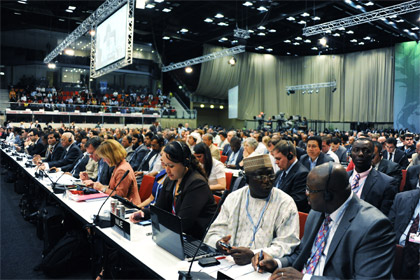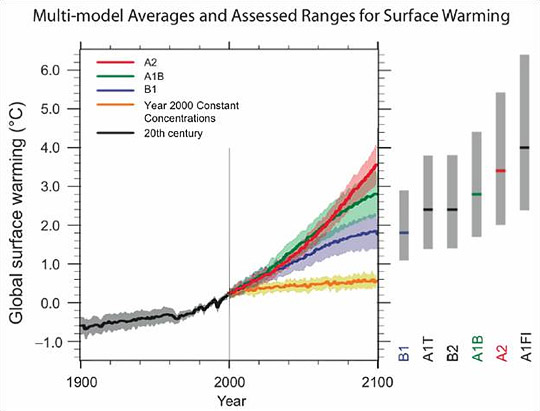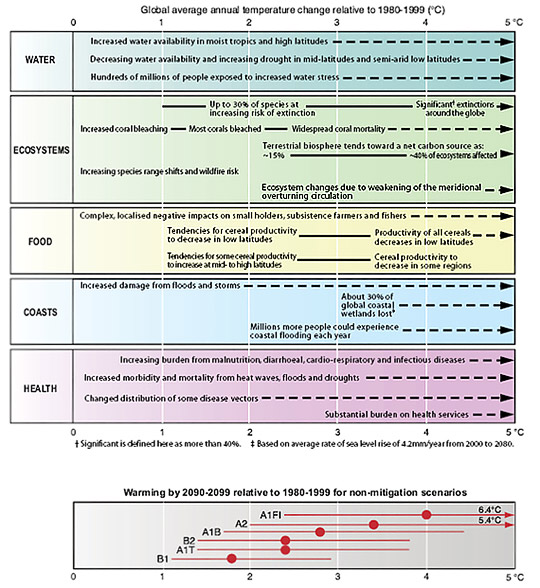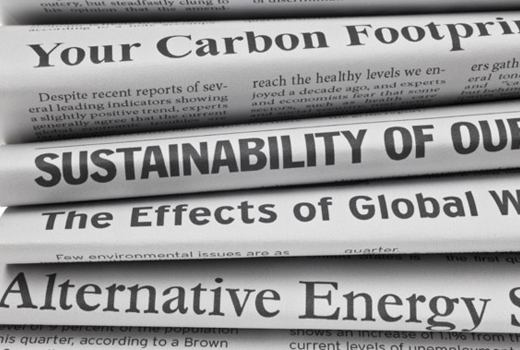Impacts of Rising Temperatures Climate Change in a Business-As-Usual World
usiness-as-usual” has been characterized as a response to climate change. This climate change scenario saves nations from expending resources to mitigation in the near-term. However, the long-term risks to our nation’s coasts, ecosystems, water, food production and health in higher adaptation costs will increase with time. Consequences of climate change in the future remain as uncertain as the potential rise in sea levels projected in ice sheet melt models. Climate change has already occurred, and more change is coming.
The Intergovernmental Panel on Climate Change (IPCC) is working towards its next major report, the Fifth Assessment Report. Working Group I will issue “The Physical Science Basis” in mid-September 2013; Working Group II will issue “Impacts, Adaptation and Vulnerability” in mid-March 2014; Working Group III will issue “Mitigation of Climate Change” in early April 2014; and the “IPCC Fifth Assessment Report (AR5)” will be issued in October 2014. The next round of IPCC assessment reports will again provide world governments with the most current scientific understanding of the state-of-knowledge about global climate change, the potential impacts to nations, and adaptation and mitigation strategies. IPCC reports are intended to be periodic assessments of the most recent scientific, technical and socio-economic information. IPCC describes these assessments as “policy-relevant but not policy-prescriptive.”
Climate Change Diplomacy & Politics
Climate change diplomacy is now 20 years old. The United Nations Framework Convention on Climate Change occurred in New York in May 1992 and was signed at the Earth Summit in Rio de Janeiro in June 1992. The Convention started a process of resolving environmental problems in a step-by-step negotiation process, which began with non-committal action plans and adopting a framework convention and protocols with binding targets. This approach was followed by negotiations on a mitigation protocol, which started in March 1994, and was followed by the “First Conference of the Parties” in Berlin, which resulted in the “Berlin Mandate,” an agenda for negotiations. Negotiations led to adoption of the “Kyoto Protocol” on December, 11, 1997, and enactment on February, 16, 2005. Detailed rules for implementation of the Protocol were adopted at COP 7 – Marrakesh Climate Conference in November 2001 and are called the “Marrakesh Accords.”
It was to take three years to reach the required 55 parties representing 55 percent of the industrialized countries’ emissions for ratification, minus ratification from the United States. Responses from the United States were consistent. James Connaughton, chairman of the White House Council of Environmental Quality said, “President Bush strongly opposes any treaty or policy that would cause the loss of a single American job let alone the nearly five million jobs Kyoto would have cost.” And Mike Leavitt, Bush’s U.S. Environmental Protection Agency Administrator, commented that Kyoto was a “bad treaty for the United States.” In December 2011 Todd Stern, United States envoy for climate change, said the European Union was the only remaining “major player” that would potentially support a continuation of the protocol after its provisions expire in 2012.

UN Photo/UNFCCC/Jan Golinski |A view of delegates at the UN Climate Change Conference in Durban, South Africa, on the conference’s opening day.
The United Nations Climate Change Conference, Durban 2011, advanced negotiations and implemented the Convention and Kyoto Protocol, Bali Action Plan and Cancun Agreements. Outcomes included a decision by Parties to adopt a universal legal agreement on climate change by 2015. President Barack Obama is expected to ask the Senate following the November 2012 presidential election to ratify the Law of the Sea Treaty, known to its critics as “LOST.” LOST has been called the “backdoor” Kyoto because it would implement applicable international rules and standards to prevent, reduce and control pollution of the marine environment from land-based sources resulting in de facto guidelines regarding energy emissions or climate change for the U.S.
In North Carolina, home to several important U.S. Department of Defense installations, the state legislature recently responded to a state commission prediction that sea levels could rise 39 inches by 2100 with House Bill 819. The bill would outlaw “scenarios of accelerated rates of sea level rise unless such rates are from statistically significant, peer-reviewed data and are consistent with historic trends.” State legislators based their projections on data from tide gauges and carbon dioxide levels, citing studies that project no or minimal sea level rise. The legislation predicts a sea level rise with an upper limit of 8 inches and contends that sea levels are actually receding in some coastal areas. They argue that the 39-inch projection would restrict economic development, increase insurance rates and decrease coastal property values. Critics have ridiculed the North Carolina Legislator’s disregard for IPCC climate change science projections. And, national headlines read that “North Carolina is making sea level rise illegal.” The U.S. Congress and coastal state legislators will likely continue to debate similar arguments until climate change theory is accepted or rejected.
Defense Department Sustainable Initiatives
“Our mission at the Department [of Defense] is to secure this Nation against threats to our homeland and to our people. In the 21st Century, the reality is that there are environmental threats, which constitute threats to our national security. For example, the area of climate change has a dramatic impact on national security: rising sea levels to severe droughts to the melting of the polar caps to more frequent and devastating natural disasters all raise demand for humanitarian assistance and disaster relief.”
Speech to the Environmental Defense Fund, May 2, 2012

U.S. Navy photo by Photographer’s |Mate 3rd Class Kristopher Wilson
The U.S. Navy instituted Task Force Climate Change & Task Force Energy in response to environmental national security concerns.
The U.S. Department of Defense (DoD) is the nation’s single largest consumer of energy. Military planners are concerned about environmental threats, which constitute threats to U.S. national security. The ongoing debates about how high Earth’s temperature will rise or what percentage of global warming is man-made versus natural are all couched in viewing current and future consequences of climate change as a national security threat. Climate change becomes another planning exercise in uninterrupted military operations, which is focused on worst-case scenarios.
The Center for Naval Analysis (CNA) and its Military Advisory Board (MAB) have previously reported the following in National Security and the Threat of Climate Change: “Climate change is a dire national security issue as altered weather patterns, including flooding and droughts, will increasingly push countries into humanitarian crises; tropical storms will displace citizens and result in mass migrations and refugees; and scarcity of food and resources will increase the likelihood of violent conflict in regions of the world where radicalism and insurgency are already likely to take hold.” Retired U.S. Air Force General Charles Wald, member of the CNA’s MAB articulated the future of DOD energy planning when he stated, “They (DoD) also understand that through proper preparation and aggressive research and development, the Department of Defense can play a key role in mitigating the risks of climate change and spurring innovations that can be beneficial not only to our fighting forces but to the Nation as a whole.”
As part of that key role, DoD announced in January 2010 that it would reduce greenhouse-gas emissions from non-combat activities 34 percent by 2020. Overall reduction in energy usage is part of a broader Defense Department effort to use energy more efficiently and to shift toward renewable energy sources. The Department’s fuel costs have increased substantially to about $17 billion in FY2011. Petroleum-based liquid fuels are the largest source of energy and account for approximately two-thirds of DoD energy consumption. Approximately 75 percent of Defense energy use is operational and about 25 percent is installation energy. In the Department’s FY2013 budget submission, it has requested more than $1.4 billion for operational energy initiatives.
Business-As-Usual Projections
IPCC was created in 1988 to evaluate causes and effects of climate change and to collect scientific peer reviewed and published scientific and technical literature. IPCC does not conduct its own research. Science panels collect and summarize literature and review panels validate findings resulting in published IPCC Assessment Reports, which began in 1990 and have been subsequently updated in 1995, 2001, 2007 and the upcoming IPCC Fifth Assessment report in 2014. In its Fourth Assessment Report in 2007, IPCC projected a global sea level rise increase of 18 to 59 centimeters from 1990 to the 2090s, plus an unspecified rise as a result of accelerated melting of large ice sheets covering Greenland and Antarctica.
Best estimates and likely ranges for global average temperature increases for the six Special Report on Emissions Scenarios (SRES) emissions marker scenarios were presented in the IPCC Fourth Assessment Report (AR4) and shown in Figure 1. The best estimate for the low scenario (B1) is a global increase in temperature of 1.8°C (likely range is 1.1°C to 2.9°C), and the best estimate for the high scenario (A1FI) is a global increase in temperature of 4.0°C (likely range is 2.4°C to 6.4°C).

Figure 1 – Image Courtesy of Alion Science and Technology Corporation | IPCC Forth Assessment Report Global Temperature Projections to 2100
(Figure SPM-5 from the AR4).
Coastal Impacts. In a business-as-usual scenario, following a 1°C increase in global temperature, frequency and severity of extreme weather events begins to increase with droughts, floods, hurricanes and climate-driven wildfires causing multi-billion dollar losses. These extreme weather events will likely become more frequent as higher sea-surface temperatures result in stronger and more damaging hurricanes along the Atlantic and Gulf Coasts. As global temperatures increase further, future hurricanes will displace larger populations and cause more private property damage as higher sea levels exacerbate coastal storm surges, inland flooding and beach erosion.
Damage to public infrastructure (highways, powerlines, sewer and water) will likely impact coastal DoD installations as displaced populations result in civil disorder and interruptions of Defense Department operations. At an increase of 3°C, the United States will have lost 30 percent of its coastal wetlands. Ecosystem function will be disrupted in the remaining wetlands as species are unable to migrate inland to higher elevations in response to the rapid rise in sea level. The National Resources Defense Council (NRDC) estimates the average annual hurricane damages in 2100 will grow to $422 billion.
Ecosystem Impacts. As global temperatures increase from 1 to 2°C, up to 30 percent of species are at an increased risk of extinction by 2050. The threat of extinction to species that are unable to adapt or have limited habitat is expected to increase as climate changes. Fauna and flora responses vary greatly between species, but climatic changes will result in disruption of biotic interactions, such as predator/prey interactions, and changes to ecosystem composition and function. Habitat fragmentation and loss, competition from invasive species, natural disturbances, pollution and other human-induced issues are expected to increase as global temperatures rise.
Species are unlikely to migrate together as communities, thus creating imbalanced ecosystems and allowing new, invasive species to establish and replace existing plant and animal communities. At the current rate of extinction, Earth will lose 25 percent of its present number of species by 2050. Plant and animal species will respond to warming by increasing their normal ranges and migrating poleward and to higher elevations as their current habitat becomes unsuitable.
Water Impacts. As climate changes, water supplies will be exacerbated by drought conditions and disruptions to existing patterns of water supply. Increases in global temperature are expected to increase limitations on water resources for population growth and will increase land-cover and land-use changes. Mountain snowpack in the western United States plays a critical role in freshwater availability for urban populations and the region’s agricultural production. Reductions in snow cover seen in recent decades are projected to accelerate by 2100, thus reducing water availability and hydroelectric power generation, and changing seasonal flows in parts of the country supplied by melt water from watersheds in major mountain ranges. Water availability will decrease in mid-latitudes and semi-arid low latitudes due to decreases in rainfall and higher rates of evapo-transpiration.
Semi-arid areas in the western United States will likely see a decrease in water resources due to increases in global temperatures. Drought-affected areas are projected to increase in extent with potential for adverse impacts on agriculture, energy production and water supply. Increases in frequency and severity of floods and droughts are projected to adversely impact sustainable development. Increased temperatures will further affect physical, chemical and biological properties of freshwater lakes and rivers with predominantly adverse impacts on many individual freshwater species, aquatic community composition and water quality. In coastal areas of the Atlantic and Gulf Coasts, sea level rise will worsen water quantity and quality due to increased salinization of groundwater supplies.

© iStockphoto.com/WendellandCarolyn | Global increase in temperatures is decreasing corn production.
Food Production Impacts. Increases in global temperatures will result in major shifts in food production. Rising temperatures will accompany increased rainfall in some parts of the globe; in others, rainfall will decrease. In North America, increases in global temperatures, soil moisture, carbon dioxide and pests associated with global warming are expected to decrease food-crop production by as much as 27 percent. Estimates of cropland reductions vary widely from 10 to 50 percent as a result of altered production of rice, wheat, corn, soybeans and potatoes in North America and globally. In addition, coastal flooding will reduce the amount of suitable land available for agriculture production.
Crop productivity is projected to increase slightly at mid-to high-latitudes for local mean temperature increases of up to 1° to 3°C, depending on the crop, and then decrease beyond that in some regions. At lower latitudes, especially in seasonally dry and tropical regions, crop productivity is projected to decrease for even small local temperature increases (1 to 2°C), which would increase risk of food shortages. Globally, potential for food production is projected to increase with increases in local average temperature over a range of 1° to 3°C, but above this it is projected to decrease.
Changes in global food production represent a strategic threat to the United States. The stability of developing countries is endangered due to rising grain prices, partially a result of fluctuating fuel prices. The recent surge in prices has reduced purchasing power and inhibited the ability of poor countries to import food. Thirty countries have experienced food-related unrest. Acutely at risk are large, heavily urbanized nations in the Middle East and North Africa. As global temperatures increase from 1° to 4°C, a wide range of developing countries will struggle to access affordable, adequate food supplies with uncertain consequences.
Health Impacts. Increases in global temperatures are a significant and emerging threat to public health in the United States and globally. Climate change will alter the way people look at protecting civilian populations. The Nation’s infrastructure is designed for a specific climate. Food production and distribution, fresh water quantity and quality, energy production, public sewer, city and town drainage and sanitation systems, housing and health infrastructure are all planned and constructed around regional climate. Health risks to vulnerable populations can arise when any one of these systems fails or becomes compromised during extreme climate events.
The health status of millions of people is projected to be affected through increased malnutrition of the poor, increased deaths from temperature extremes, increases in tropical diseases from altered spatial distribution of some infectious diseases, personal injury due to extreme weather events and increased frequency of cardio-respiratory diseases from increasing concentrations of air pollutants. Overall, it is expected that benefits will be outweighed by negative health effects of rising temperatures, especially in developing countries. Critically important will be factors directly shaping population health, such as public health infrastructure, education, health care, public health initiatives and economic development.
Climate change currently contributes to 150,000 deaths and five million illnesses each year. And, the World Health Organization (WHO) estimates one-quarter of the world’s disease burden is due to contamination of air, water, soil and food. Climate-sensitive diseases are responsible for the largest number of global deaths. Diarrhea, malaria and malnutrition were responsible for more than 3.3 million deaths globally in 2002 with 29 percent of these deaths occurring throughout Africa. Diseases associated with temperature extremes, such as West Nile virus, Cholera and Lyme disease, are spreading rapidly throughout North America and globally because increased temperatures allow disease carrying vectors to thrive.

Figure 2. Image Courtesy of Alion Science and Technology Corporation | Impacts Associated with Global Average Temperature Change
(Figure SPM-7 from the AR4).
Mitigation & Adaptation
Greenhouse gases that have been added to the Earth’s atmosphere and oceans, and the ever increasing rate with which these gases continue to be added, will ensure nations will be forced to adapt to a changing world. In order to prevent even more extreme climate changes from increasing global temperatures, nations will have to implement mitigation actions to reduce carbon dioxide and other greenhouse gases. Nations are examining climate change risks and their adaptation and mitigation options. They will have to find a balance among competing economic and social concerns.
DoD is also balancing competing concerns with adoption of a new operational energy strategy designed to transform the way it consumes energy in military operations. More fight, less fuel. More options, less risk. More capability, less cost. In 2010, the Defense Department required approximately five billion gallons of petroleum in military operations at a cost of $13.2 billion, a 255 percent increase beyond 1997 prices. DoD accounts for 80 percent of the federal government’s energy use and one percent of the nation as a whole. As the Department diversifies its energy sources and supplies in order to have a more reliable and assured supply of energy for military missions, it too will be faced with adaptation and mitigation strategies. The Kyoto Protocol will present future challenges to DoD in energy efficiencies, reduction of carbon dioxide and other greenhouse gases, elimination of ozone depleting substances, production of new weapon systems, and developing and securing alternative fuels to man, equip and train its forces.





























